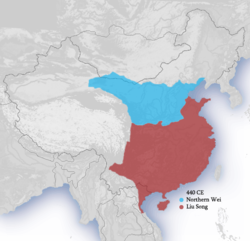Southern and Northern Dynasties
| Northern and Southern dynasties | |||||||||||||||||||||

Approximate territories of the Northern Wei (blue) and Liu Song (maroon) states in 440
|
|||||||||||||||||||||

Northern and Southern Dynasties by 560
|
|||||||||||||||||||||
| Chinese | 南北朝 | ||||||||||||||||||||
|---|---|---|---|---|---|---|---|---|---|---|---|---|---|---|---|---|---|---|---|---|---|
|
|||||||||||||||||||||
| Transcriptions | |
|---|---|
| Standard Mandarin | |
| Hanyu Pinyin | Nán-Běi Cháo |
| Wade–Giles | Nan2-pei3-ch'ao2 |
| IPA | [nǎnpèi̯ʈʂʰǎu̯] |
| Yue: Cantonese | |
| Yale Romanization | Nàahm-bāak-chìuh |
| Jyutping | Naam4-baak1-ciu4 |
| Southern Min | |
| Tâi-lô | Lâm-pak-tiâu |
The Northern and Southern dynasties (Chinese: ; pinyin: Nán-Běi Cháo) was a period in the history of China that lasted from 420 to 589, following the tumultuous era of the Sixteen Kingdoms and the Wu Hu states. It is sometimes considered as the latter part of a longer period known as the Six Dynasties (220 to 589). Though an age of civil war and political chaos, it was also a time of flourishing arts and culture, advancement in technology, and the spread of Mahayana Buddhism and Daoism. The period saw large-scale migration of Han Chinese to the lands south of the Yangtze. The period came to an end with the unification of all of China proper by Emperor Wen of the Sui Dynasty.
During this period, the process of sinicization accelerated among the non-Chinese arrivals in the north and among the indigenous people in the south. This process was also accompanied by the increasing popularity of Buddhism (introduced into China in the 1st century) in both northern and southern China and Daoism gaining influence as well, with two essential Daoist canons written during this period.
Notable technological advances occurred during this period. The invention of the stirrup during the earlier Jin dynasty (265–420) helped spur the development of heavy cavalry as a combat standard. Historians also note advances in medicine, astronomy, mathematics, and cartography. Intellectuals of the period include the mathematician and astronomer Zu Chongzhi (429–500).
...
Wikipedia
